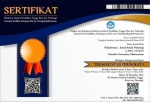Pengaruh Persepsi Resiko dan Komunikasi Mulut ke Mulut Pada Media Elektronik Terhadap Kepercayaan Konsumen Dalam Pembelian Produk Fashion di E-Commerce
Abstract
Penelitian ini bertujuan untuk mengetahui pengaruh persepsi risiko dan komunikasi mulut ke mulut pada media elektronik terhadap kepercayaan konsumen dalam pembelian produk fashion di e-commerce. Penelitian ini menggunakan pendekatan kuantitatif. Subjek penelitian berjumlah 125 pengguna Shopee di kota Samarinda yang dipilih dengan menggunakan teknik purposive sampling. Metode pengumpulan data yang digunakan adalah metode skala likert. Data yang terkumpul dianalisis dengan uji analisis regresi linear berganda dan sederhana dengan bantuan program Statisical Package for Social Sciences (SPSS) 22.0 for windows. Hasil penelitian menunjukkan bahwa: (1) Terdapat pengaruh antara persepsi risiko dan komunikasi mulut ke mulut pada media elektronik terhadap kepercayaan konsumen dengan nilai F hitung > F tabel (31.460 > 3.07), adjusted R Square = 0.340, dan p = 0.000; (2) Terdapat pengaruh yang signifikan antara persepsi risiko dan kepercayaan konsumen dengan nilai beta (β) = -0.580, t hitung > t tabel (-8.389 > 1.658), dan p = 0.000; (3) Terdapat pengaruh yang signifikan komunikasi mulut ke mulut pada media elektronik dengan kepercayaan konsumen dengan nilai beta (β) = 0.303, t hitung > t tabel (-4.384 < 1.658), dan p = 0.000.
This study aims to determine the effect of perceived risk and electronic word of mouth on consumer trust in purchasing fashion products in e-commerce. This study uses a quantitative approach. The subjects of this study were 125 Samarinda city Shopee customers who were selected by using purposive sampling technique. The data collection methods used is the scale of likert. The collected data were analyzed with multiple linear regression analysis tests and simple with the help of the Statistical Package for Social Sciences (SPSS) 22.0 for windows program. The results of the study showed that: (1) there is a positive and significant influence of perceived risk and e-wom on consumer trust with a calculated F value > F table (31.460 > 3.07), adjusted R Square = 0.340 and p = 0.000. (2) In the results of the step-by-step model of research it is found that there is a significant influence between perceived risk and consumer trust with the value of beta (β) = -0.580, t value > t table (-8.389 > 1.658), and p = 0.000. (3) Then on e-wom with consumer trust showed shows there is an influence with the value of beta (β) = 0.303, t value < t table (4.384 > 1.658), and p = 0.000.
Keywords
Full Text:
PDFReferences
Alcocer, N.H. (2017). A literature review of word of mouth and electronic word of mouth: Implications for consumer behavior. Frontiers in Psychology, 8(1). Doi: 10.3389/fpsyg.2017.01256
Arikunto, S. (2010). Prosedur penelitian: Suatu pendekatan praktik (edisi revisi). Jakarta: Bumi Aksara.
Ardiansyah, A.M., Saputri, A., Lawolo, A.N., & Arsha, J.S. (2018). Vipassana sebagai upaya preventif bagi penderita fear of missing out. Psikostudia: Jurnal Psikologi. 7(1), 50-59. ISSN: 2302-2582
Ariyanti, K., & Iriani, S.S. (2014). Pengaruh persepsi nilai dan persepsi resiko terhadap niat beli kosmetik organik. Jurnal Ilmu Manajemen, 2(4), 1189-1190. Diakses dari https://jurnalmahasiswa.unesa.ac.id/index.php/jim/arti cle/view/10212
Asosiasi Penyelenggara Jasa Internet Indonesia (2018). Penetrasi dan profil perilaku pengguna internet Indonesia. Jakarta, DKI: Penulis. Diakses dari https://apjii.or.id/survei
Ba, S., & Pavlou, P.A. (2002). Evidence of the effect of trust building technology in electronic market: Price premiums and buyer behavior. MIS Quarterly Journals. 26(3), 243-246. Diakses dari https://www.researchgate.net/ publication/220260005_Evidence_OF_the_Effect_of_Trust_Building_Technology_in_Electronic_Markets_Price_Premiums_and_Buyer_Behavior
Bhatnagar, A., & Ghose, S. (2004). Segmenting consumers based on the benefits and risks of Internet shopping. Journal of Business Research, 57(12), 1352–1360. doi:10.1016/s0148-2963(03)00067-5
Cazier, J.A. (2007). A framework and guide for understanding the creation of consumer trust. Journal of International Technology and Information Management, 45(3): 45-56.
Chang, H., & Wang, H.W. (2011), The moderating effect of customer perceived value on online shopping behaviour. Online Information Review, 35(3), 333-359. Diakses dari https://www.emerald.com/insight/content/doi/ 10.1108/14684521111151414/full/html
Chatterjee, P. (2001), Online reviews: Do consumers use them?. ACR 2001 Proceedings, 129-134. Diakses dari https://www.researchgate.net/ publication/228191390_Online_Reviews_Do_Consumers_Use_Them
Cheung, C.M.K., & Thadani, D. (2010). The state of electronic word of mouth research: A literature analysis. BLED Proceedings, 329-345.
Darmawi, H. (2008). Manajemen risiko. Jakarta: Bumi Aksara.
Firdayanti. (2012). Persepsi resiko melakukan e-commerce dengan kepercayaan konsumen dalam membeli produk fashion online. Jurnal Sosial dan Psikologi Industri, 1(1), 1-7. Diakses dari http://journal.unnes.ac.id/ sju/index/php/sip
Forsythe, S., & Shi, B. (2003). Consumer patronage and risk perceptions in internet shopping. Journal of Business Research, 56(11), 867-875. Doi: 10.1016/S0148-2963(01)00273-9
Gruen, T. W., Osmonbekov, T., & Czaplewski, A. J. (2006). eWOM: The impact of customer-to-customer online know-how exchange on customer value and loyalty. Journal of Business Research, 59(4), 449–456. Doi:10.1016/j.jbusres.2005.10.004
Goyette, I., Ricard, L., Bergeron, J., Marticotte, F. (2010). E-Wom scale: Word-of-mouth measurement scale for e-services context. Journal of Administrative Sciences, 27, 5-23. Doi: 10.1002/CJAS/129
Haekal, M.E., Suharyono., Yuliyanto, E. (2016). Pengaruh electronic word of mouth terhadap kepercayaan dan keputusan pembelian. Jurnal Administrasi Bisnis, 40(2), 162-168. Diakses dari administrasibisnis.studentjournal.ub.ac.id
Hadi, S. 2004. Penelitian research. Yogyakarta: BPFE
Iprice. (2020). Peta E-Commerce Indonesia. Diakses dari https://iprice.co.id/ insights/mapofecommerce/
Ismagilova, E., Slade, E.L., Rana, N.P., & Dwivedi, Y.K. (2019). The effect of electronic word of mouth communications on intention to buy: A meta-analysis. Information System Frontliers, 22(1), 1203-1226. Doi:/ 10.1007/s10796-019-09924-y
Jeong, H. J., & Koo, D. M. (2015). Combined effects of valence and attributes of e-WOM on consumer judgment for message and product: The moderating effect of brand community type. Internet Research, 25(1), 2–29. Doi: 10.1108/IntR-09-2013-0199
Kamtarin, M. (2012). The effect of electronic word of mouth, trust and perceived value on behavioral intention from the perspective of consumers. International Journal of Academic Research in Economics and Management Sciences, 1(4), 56-66.
Krauter, S.K. & Kaluscha, E.A. (2003). Empirical research in online trust: A review and critical assessment. Journal Human-Computer Studies, 58, 783-812. Doi: 10/1016/S1071-5819(03)00043-0
Liramedia. (2019). Maraknya penipuan olshop, barang yang dikirim tidak sesuai dengan pesanan. Diakses dari http://liramedia.co.id/read/maraknya-penipuan-olshop-barang-yang-dikirim-tidak-sesuai-dengan-pesanan
Liu, Y., Li, H. & Hu, F. (2013). Website attributes in urging online impulse purchase: An empirical investigation on consumer perceptions. Journal Decision Support Systems, 55(3), 829-837. Doi:10.1016/j.dss.2013.04.001
Mayzlin, D. (2006). Promotional chat on the internet. Marketing Science, 25(2), 155–163. Doi: 10.1287/mksc.1050.0137
McKnight, Harrison, Choudhury. V., & Kacmar, C. (2002). The impact of initial consumer trust on intentions to transact with a website: A trust building model. Journal of Strategic Information Systems, 11, 297-323. Diakses dari http://www.elsevier.com
Nugroho, A. (2006). E-Commerce – memahami perdagangan modern di dunia maya. Bandung: Informatika.
Peter, P.J., & Olson, J.C. (2010). Consumer Behavior and Marketing Strategy. New York: Mcgraw Hill Higher.
Prakosa, A., & Sumantika, A. (2019). Analisis pengaruh persepsi teknologi dan persepsi risiko terhadap kepercayaan pengguna m-banking. Jurnal Manajemen, 9(2), 270-282. Diakses dari https://media.neliti.com/media /publications/300044-analisis-pengaruh-persepsi-teknologi-dan9127897d
Ramsey, B., & Sohi, J., (2007), User's willingness to pay on social network sites. Journal of Computer Information Systems, 51(4) 187-199.
Rohmad, H., & Supriyanto. (2015). Pengantar statistika. Yogyakarta: Kalimedia.
Rosalia, D. (2016). Pengaruh persepsi risiko terhadap kepercayaan dan keputusan pembelian online (Thesis). Universitas Atma Jaya, Yogyakarta.
Schiffman, L. & Kanuk, L.L. (2007). Perilaku konsumen (edisi ke-9). (Kasip, Z. Trans.). Jakarta: Indeks.
Shidqi, H., Noor, Y. L., & Kirbrandoko. (2019). The effect of electronic word of mouth on online trust and purchase intention among millenials generation on instagram. Russian Journal of Agricultural and Socio-Economic Sciences, 85(1), 490–496. https://doi.org/10.18551/rjoas.2019-01.60
Shopee. (2020). Shopee is the leading e-commerce platform in Southeast Asia and Taiwan. Diakses dari https://careers.shopee.co.id/about/
Sonja, G. K, & Ewald A. K.. (2003). Empirical research in online trust: A review and critical asessement. International Journal of Human-Computer Studies, 586, 783-812. Doi: 10.1016/S1071-5819(03)00043-0
Sugiyono. (2015). Metode penelitian kuantitatif kualitatif dan r&d. Bandung: Alfabeta.
Suryani, T. (2013). Perilaku konsumen di era internet. Yogyakarta: Graha Ilmu.
Thurau, H.T., Gwinner, K. P., Walsh, G., & Gremler, D. D. (2004). Electronic word-of-mouth via consumer-opinion platforms: what motivates consumers to articulate themselves on the internet?. Journal of Interactive Marketing, 18(1), 38–52. Doi:10.1002/dir.10073
DOI: http://dx.doi.org/10.30872/psikoborneo.v9i3.6503
Refbacks
- There are currently no refbacks.
Copyright (c) 2021 Psikoborneo: Jurnal Ilmiah Psikologi

This work is licensed under a Creative Commons Attribution-ShareAlike 4.0 International License.
Indexing by :
________________________________________
PSIKOBORNEO: Jurnal Ilmiah Psikologi Published by Faculty of Social and Political Siences, University of Mulawarman, Samarinda, East Kalimantan and This work is licensed under a Creative Commons Attribution-ShareAlike 4.0 International License.
________________________________________
PSIKOBORNEO: Jurnal Ilmiah Psikologi
Department of Psychology
Faculty of Social and Political Siences, University of Mulawarman
Jl. Muara Muntai Kampus Gn. Kelua Samarinda 75411
Phone: +62 813 35350368
E-Mail: psikoborneo@gmail.com / psikoborneo@fisip.unmul.ac.id

















